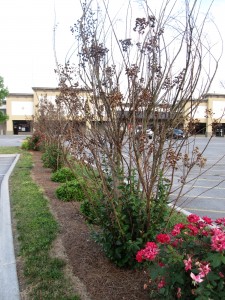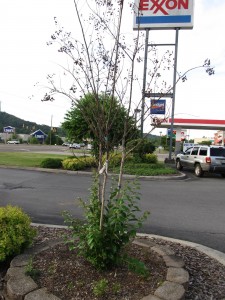Crape myrtles (Lagerstroemia indica and hybrid cultivars) are rated as hardy perennials and semi-hardy shrubs or trees in USDA zone 6 and parts of zone 7. Since the year 2000, an average of 1 out of 3 winters has killed some crape myrtles to the ground. By late May new shoots emerge from the very hardy rootsystem below ground or from lower areas on the shrub or tree that were not injured by winter cold.
In general, crape myrtles grow very rapidly, assisted by adequate soil moisture and spring fertilizing. New shoots may also push out in upper parts of the plant, but are removed. It is best to severely cutback the plant or multi-branches near the base to invigorate numerous new shoots to pop out in the coming weeks
Repaired crape myrtle(s) bloom on new summer wood, so flowering is not lost, just delayed a few weeks.
Additional cultural tips: feed your shrub or tree crape myrtle immediately after pruning, using 10-10-10 or equivalent fertilizer. Lightly mulch around the base of the plant for a neat weed-free look. Irrigate only during long summer dry spells. When large numbers of new shoots form, you may opt to re-prune and eliminate all but 1, 3, 0r 5 shoots. By reducing numbers, the remaining shoots grow taller and still bloom.
Never, never prune or fertilize crape myrtles in fall and through most of the winter season.



 Posted in
Posted in 
